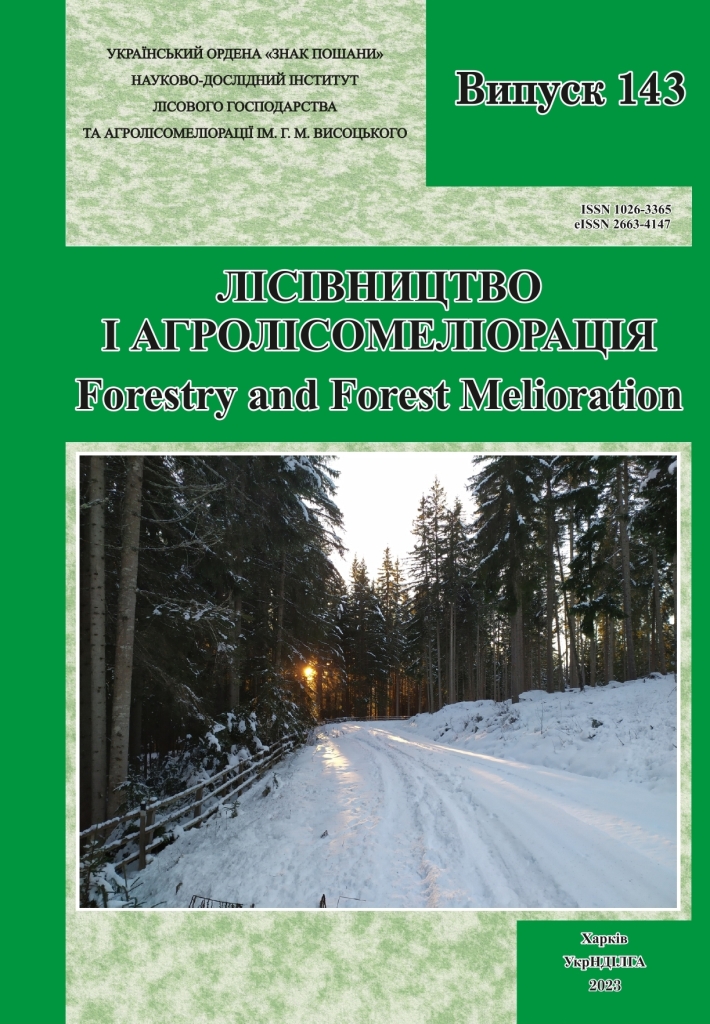Abstract
Introduction
The increasing temperatures during the growing season in combination with periodic droughts (especially in the last decade) cause the spreading of forest diseases. The research aimed to determine the specificities of pathological processes in the forests in Cherkasy region and the impact of climate changes in 2008–2021 on their health condition.
Material and Methods
Climatic changes were assessed by analyzing temperature and precipitation for the growing seasons of 2008-2021 according to the data of six climate stations in the region and the fluctuation of groundwater levels according to the data of the Institute of Hydrology (Kyiv). Based on the ratio of precipitation and evaporation, moisture coefficients were calculated according to Vysotsky and Ivanov. Changes in the health condition state of pine stands in Cherkasy region for 1992–2018 were analyzed based on forest pathology information from State Specialized Forest Protection Enterprise ‘Kyivlisozakhyst’ and Ukrainian Research Institute of Forestry and Forest Melioration.
Results
From 1994 to 2012, the area of forest stands in which pathological processes were detected gradually and unevenly increased. As of 2021, the area of such stands was about 21,000 hectares. Among them, the largest area is occupied by pine stands (64%) of VII–IX age classes (61%), with a relative density of stocking of 0.7 (62%). The main causes of pine forest deterioration in 2018 were hydrological and climatic factors (74%), while in 2021 there were a variety of diseases. Particularly, the semi-parasitic plant Viscum album ssp. austriacum (Wiesb.) Vollm. on 11.3 thousand ha, root rot on 2.9 thousand ha, needle-eating insects on 2.9 thousand ha were spread, and 0.7 thousand ha were damaged by windstorms. From 2018 to 2021, the area of pine stands with pathological processes has been increased more than five times. The precipitation and temperature during the growing season on the spread of forest pathological processes had direct medium and weak correlations with forest decline area. Changes in the moisture coefficient indicate a tendency to an uneven increase in aridity in the growing seasons of 2008–2021. Groundwater in the right-bank part of Cherkasy region is mainly located at a depth inaccessible to pine root systems.
Conclusions
Pathological processes in the forests in Cherkasy region are widespread in pine forests of VII–IX age classes (61%), with a relative density of stocking of 0.7 (62%). While as of 2018, the main causes of deterioration were hydrological and natural phenomena, as of 2021 they were diseases (root rot), stem pests, and a semi-parasitic plant (Austrian mistletoe). During these years, the moisture regime during the growing season corresponded mainly to the conditions of the dry steppe. The water regime of forest stands in these conditions depends mainly on surface moisture.
4 Figs., 4 Tables, 9 Refs.
References
Balabukh, V. O. and Malytska, L. V. 2017. Assessment of modern changes in the thermal regime of Ukraine. Geoinformatics, 4(64): 34–49 (in Ukrainian).
Iliuha, O. V. 2014. Spacious and quantitative regularities of bird migration in the region of Kremenchuk reservoir in the daytime. [Electronic resource]. Herald of the Cherkasy University. Series: Biological sciences, 36: 27–34. Available at: http://nbuv.gov.ua/UJRN/VchuB_2014_36_6 (accessed 21.06.2023) (in Ukrainian).
Malytska, L. V. and Balabukh, V. O. 2020. Probable changes in the climatic conditions of Ukraine by the middle of the 21st century Hydrology, Hydrochemistry and Hydroecology, 1(56): 94–100 (in Ukrainian).
Moisture coefficient: study guide. 2013. Lanovenko, O. G. & Ostapishyna, O. O. (Eds.). Kherson, PP Vyshemirskyi V. S., 107 p. (in Ukrainian).
Sanitary Forests Regulations in Ukraine. 2016. [Electronic resource]. Resolution of the Cabinet of Ministers of Ukraine No 756 dated 26 October 2016. Available at: http://zakon2.rada.gov.ua/laws/show/555-95-п (accessed 21.06.2023) (in Ukrainian).
Shvidenko, A. Z., Buksha, I. F., Krakowska, S. V. 2018. Vulnerability of Ukraine’s forests to climate change. Kyiv, Nika-Center, 184 p. (in Ukrainian).
To study the causes of widespread forest dieback. To justify measures to increase their stability. 1997. Final scientific report on topic No. 121. State registration No 0194U012789 mF 0200U003250. Kharkiv, URIFFM, 283 p. (in Ukrainian).
Ustskyi, I. M. 2008. Methodical guidelines for collecting information for the subcompartment database of forest stands in Ukraine in which pathological processes have been detected. Kharkiv, URIFFM, 14 p. (in Ukrainian).
Vermenych, Ya. V. 2013. Cherkasy region. In: Encyclopedia of the history of Ukraine: in 10 volumes. Smoliy, V. A. et al. (Eds.); Institute of History of Ukraine, National Academy of Sciences of Ukraine. Kyiv, Naukova Dumka, Vol. 10: T–Ya, p. 497 (in Ukrainian).

This work is licensed under a Creative Commons Attribution 4.0 International License.
